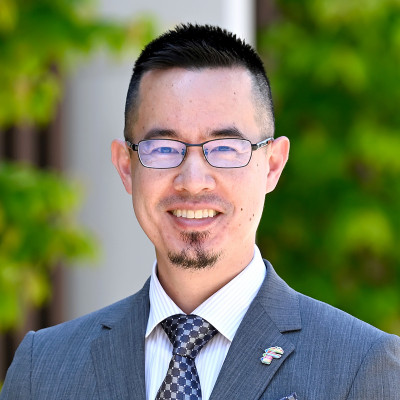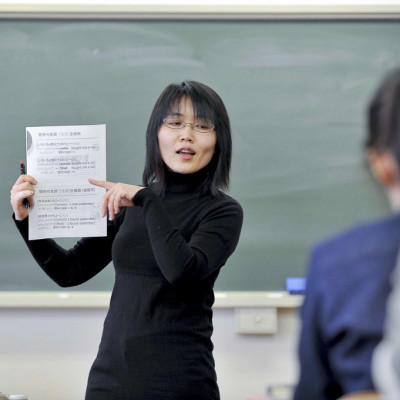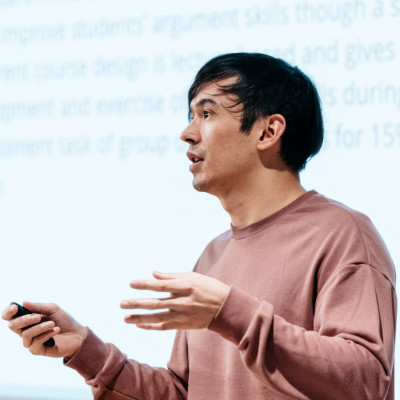Sessions / Location Name: Zoom D
Virtual Location
Virtual: You cannot enter virtually via this page. Click on the titles of individual presentations or go to the Live Page
Real Time Transcription & Translation for Class Instruction and Lecture: A Workshop #3055
Transcription and translation: two tools that help foster a more inclusive classroom experience for different types of learners but more importantly create a more effective and engaging classroom environment. The presenter discusses he setups, maintains and conducts an English language class using speech-to-text technology and real-time translation in both online and face-to-face settings. We will also cover the reasoning, strengths & limitations of this technology and have a refresher on speaking best practices. Participants are asked to install PowerPoint and Google Translate, have a Bluetooth or regular microphone ready as they will be trying it themselves.
Learning 21st-century skills and cross-cultural awareness through collaborative learning during the COVID-19 #3085
The purpose of this study is to investigate the effects of dialogue with CCC (Campus Crusade for Christ) members (1 CCC vs 3 students) on the attitudes of Japanese English learners toward communicating in English. Through the use of surveys and pre-post OPIc Speaking Tests, the authors investigate how students feel about speaking English and the effects of regular encounters with CCC members on their confidence and ability to communicate. From April 2021 to January 2022, the participants were 17 Japanese university students who studied English and presentation skills through a variety of topics derived from epistemology and ontology in order to prepare for a digitalized society 5.0. The pedagogical training was geared toward assisting students in identifying and solving the many critical issues facing humanity in the twenty-first century. A strong emphasis was placed on the development of higher-order thinking skills as well as the integration of ICT and human discourse throughout the 30-week online course. The students delivered numerous presentations using digital storytelling techniques on topics such as the Sustainable Development Goals (SDGs), global leadership, artificial intelligence (AI), cross-cultural quotient about different cultures, EduTech (21st-century skills), science and theology, and more. Aside from that, young foreigners visited virtual courses roughly every two or three weeks to assist students with presentations and debates. They also evaluated the students' presentations using the PeerEval program, which was provided by the university. The results showed that the mean OPIc speaking test score increased from 6.7 (standard deviation:1.36) to 7.4 (standard deviation:1.36) (SD:1.97). The classes they observed throughout the two semesters changed their ideas on studying cross-cultural communication skills and English proficiency, contextualizing and socializing their learning in the setting of an engaged and meaningful training environment. The results of the questionnaires that were conducted will be discussed in greater depth.
A new extensive speaking tool for Moodle #2934
This presentation will introduce a new extensive speaking tool for Moodle that can translate and score student speech. The tool is intended to provide translation and pronunciation support for lower-level language learners. When learners are engaged in speaking tasks, they often process their ideas in the L1, causing fluency issues with L2 production. In order to improve forward momentum with speaking tasks, a new speaking tool is being developed that allows a learner to speak a phrase or sentence in their L1, listen to a translation of the phrase or sentence in the L2, and practice speaking the language in the L2. This tool enables students to assemble a database of new L2 words and phrases over time. To use the tool, learners speak into the microphone using their L1, and listen to a spoken translation of their L1 phrase. Their spoken utterance is then automatically scored based on how well the student is able to speak the new word or phrase. Learners have the opportunity to listen to the pronunciation of new words or phrases used in a specific context, and can practice their production skills as they repeat the language in the L2. Practice language tasks or language tests can be generated based on the database of items generated by a learner or an entire class. The Moodle plugin, developed by the presenter, can be used as a teaching tool to identify language items that students need to review.
Influence of Using Online Tools for Self-Regulated Strategy Development on Emergent Researchers' Academic Writing #3087
Learners with self-regulation skills have better academic writing achievement levels. With the advances in technology, online tools are designed to support EFL writers’ academic writing. Systematic trainings on self-regulated strategy development and the applications of online tools into academic writing have been suggested. Online tools were introduced and integrated into two academic writing courses in a university in northwest Taiwan. Twenty-six seniors and twelve first-year graduate students were recruited based on the convenience sampling method. Moving beyond the current empirical studies on self-regulated strategy development on academic writing on one specific writing process, this case study explored the influence of using online tools for fostering these participants’ self-regulated strategy development and academic writing from outlining, drafting, and revising. The descriptive analysis of the questionnaire and thematic analysis of the qualitative data (e.g. the instructor’s PowerPoint slides, participants’ learning records on self-regulated tools, and participants’ writing tasks) reached the following conclusions. First, participants tended to use online tools to self-monitor and self-correct their writing, rather than peer-review. Secondly, with the instructor’s instruction on the structure of academic writing via PowerPoint slides, participants were more motivated to use online tools (e.g. Linggle, Grammarly, Endnote, Google checklist) to structure their academic writing. Thirdly, participants’ educational background and past learning experience affected their motive and attitude toward self-regulated strategy development in academic writing. To effectively improve emergent researchers’ academic writing, two major suggestions were proposed.
Promoting student interaction through Zoom polls #2946
A key challenge of synchronous hybrid instruction is finding ways to bridge the participation gap between face-to-face and online learners. What can be done to maintain a community of learners and promote accountability? How can all learners participate actively and have a voice in their learning? One tool built into the interface many of us have been teaching with is Zoom’s polling function. This talk will discuss how regularly employing Zoom polls at various lesson stages improves student engagement and allows the instructor to make real-time adjustments based on polling results. The following examples of Zoom polling uses will be demonstrated: check in/ exit questions, comprehension checking, peer assessment of presentations, and action-research surveys. Attendees will walk away with tangible examples of how Zoom polling can make classes more participatory, democratic, and engaging.
Adding rich interaction and speech scripts into a game-based communication class: A case study with the game "Sims 4" #3060
This case study is one of a series of game-based language learning (GBLL) studies using the game Sims 4, a PC-based life-simulation game that allows players to create and control characters in their lives in the game. Prior studies in the series have indicated a lack of pre-class preparation and in-class interaction in GBLL classrooms in the Japanese and Chinese contexts (see Wang, 2019 and 2020). In this study, the researcher explores in detail how preparation for speaking activities and rich interaction opportunities influence communicative competence. One female Chinese university student participated in a 2-month one-on-one GBLL class consiting of 14 two-hour sessions that included classroom instruction, gameplay, written script feedback and presentations of recorded gameplay videos. Written scripts were used as preparation for presentation and four teachers, including the teacher teaching the GBLL class, served as more capable peers interacting with the participant in her presentations. The presentations, together with a pre-test and a post-test of the participant’s communicative competence, were rated by the four teachers based on a detailed rubric that used such metrics as interaction, fluency and content. An inter-rater reliability test was conducted so that the average of teacher grading results could be valid evaluation results. A further analysis of speech rate was done to corroborate results on the metric of fluency. In addition, a pre-questionnaire and a post-interview were conducted with the student that focused on her attitudes towards GBLL and her learning experience in this class. The study concludes that rich interaction with more capable interlocutors is conducive to the participant's improvement in interaction and speech content. However, it may take much longer before any conspicuous improvements can be observed in fluency. It also shows that written scripts as preparation were helpful in the early stage when the participant was struggling to deliver the content, but counterproductive later as reciting the scripts inhibited her improved natural speech. Survey results show that the participant deemed the GBLL class very effective and innovative, because it provided her with both interesting topics to talk about and intensive language instruction from the teacher.
Practicing conversation strategies with student customizable Neural-Network Artificial Intelligence conversation partners #3050
The advent of Neural-Network Artificial Intelligence systems have given rise to much more realistic and context sensitive conversational AI than was previously possible. This project investigated whether Generative Pre-trained Transformer 3 (GPT3) Neural Network Artificial Intelligence (AI that uses deep learning to produce human-like text) can be trained to fill conversation partner roles by being fed individualized personality traits, life history, interests and dislikes created by language learning students. The researchers developed and programmed this application to also allow students to customize the appearance, accent and name of their conversation partner. In this project, 34 students from two university-level EFL classes “created” AI conversation partners, conversed with them and then provided feedback on their experiences. The project was conducted over three 90 minute lessons. During the first lesson, students created their AI conversation partners in pairs and over the subsequent two lessons, each pair interacted with their own AI for 10 minutes. Afterwards, participants completed a mixed-methods survey asking for student feedback and impressions of the experience. The researchers also collected quantitative data from the AI itself - this included the AI personality data and conversation transcripts, which were analyzed in concurrence with the survey data. The results of this project highlight the potential for the use of Neural-Network AI as a substitute for fluent speakers in language conversation centers when fluent speakers are unavailable for students to practice with (e.g. after hours/online), while also highlighting some of its remaining limitations.
The effects and implications of using a tablet to practice writing kanji #3046
Handheld devices have been available to consumers for years, and now initiatives such as the GIGA School Program in Japan have seen every schoolchild in the country receive a tablet for academic use. However, while precursor research (AUTHOR, 2020, 2021a, 2021b, 2021c) has documented the advantages of handwriting over other forms of digital writing (e.g., typing or tapping) across diverse learning outcomes (e.g., recollection, volume of output, conceptual understanding), less research has examined the impact of the writing medium (paper versus tablet). The current study compared 32 inexperienced adults’ performance in learning Japanese kanji, either on paper or on tablets. After practice sessions using each medium, the participants (L1 = English) were tasked with a) identifying the kanji by sight, b) reproducing the kanji manually, and c) providing the kanji's meanings in both Japanese and English. One significant finding was that while written performance was equal at the posttest, participants’ ability to reproduce kanji they had practiced on paper, significantly increased at the delayed posttest, though the same was not found for tablet-based kanji. Recall of English translations was also higher for paper-based kanji. In follow-up questionnaires, participants acknowledged feeling differently between the two media but generally agreed that what was needed is more practice - not the abandonment of the technology. While the current study focused on learning kanji, the same principles are theorized to apply to tablet-based writing/learning in English classrooms as well. Attendees will be able to join in discussions of the implications for teachers and learners (particularly under remote learning conditions which heavily utilize mobile devices), as well as practical ideas for incorporating tablets into pedagogy.
The state of play: a review of research on the use of digital games in CALL #3054
As research on the use of digital games in CALL continues to expand there is a need for reviews in order to ensure that development proceeds in a principled manner. In this context, this presentation is concerned with analysing the findings of learner-based research focusing on the use of digital games in foreign language learning. The findings of peer-reviewed studies informed by SLA theory are examined. Analysis demonstrates that to date, massively multiplayer online role-playing games represent the most frequently investigated game type in CALL research. It was found that the majority of studies involved EFL learners in higher education and that studies involving gaming in informal contexts were infrequent. Furthermore, it was found that mixed methods were the most frequently employed research methodology. Although research is not conclusive, findings indicate that role-playing and simulation games may facilitate vocabulary learning and retention. Moreover, research highlights the prevalence of positive learner attitudes suggesting certain digital games may reduce the influence of factors that inhibit learning. Strengths and weaknesses of the current research base are identified as are some recurrent issues that are impeding development in the field. Looking forward, the discussion highlights a number of under-researched areas including game modification and out-of-school gaming that show promise for future research.
Helping Students to Overcome Bottom-Up Listening Challenges through Voice of America Quizzes, Songs and Reaction Papers #3037
For Japanese university students, not good at understanding spoken English, one of the major challenges is that they cannot segment a speech stream and recognize words/phrases because what they hear does not match the mental acoustic image they have of them, and they are too unfamiliar with connected speech features. The speech segmentation and word recognition, components of bottom-up processing, are even harder if they are unaware of rhythmic differences between English and Japanese, subconsciously applying the Japanese rhythm structure when processing spoken English. This presentation proposes that connected speech training with explicit instruction of L1-L2 rhythmic differences should be incorporated in Japanese EFL classes to help less competent listeners to overcome such bottom-up listening challenges. The need of tuning up their mental acoustic image of words/phrases and building automaticity in using skills should also be addressed there.
The study to be reported here was conducted in the 2021 fall semester, with 31 university students enrolled in a freshman required English course. They were placed in the second-highest of five classes based on an in-house placement test in April and stayed in the same class in the fall semester. Based on observation of their performance in the spring semester, most of them had CEFR-B1-level reading skills at the beginning of the fall semester. However, a test to check their bottom-up listening skills in October (the pre-test in this study) showed that dealing with connected speech (even in A1/A2-level materials) was challenging for many, though they gained some familiarity with spoken English and its rhythm through the previous semester.
In order to train their bottom-up listening skills, more focus was placed on connected speech training in the fall semester. New additions were 1) self-grading VOA listening exercises focusing on connected speech and rhythm (used with another set of VOA quizzes for comprehension and vocabulary/grammar); 2) instructional videos (used with connected speech training through songs); 3) feedback videos (in place of written feedback) to their reaction papers in an attempt to raise metacognitive awareness. During the 13-week semester, before the class, the students worked on two VOA quizzes and song listening. In class, they received feedback on their reflections, lectures on the week’s song and VOA story, oral practice opportunities, and further exercises. Then they were given automaticity/fluency building activities via Kahoot!/Quizlet Live and speech production. Finally, they reflected on their learning and performance to submit the week’s reaction paper. In Week 13 they took the same bottom-up listening skills test (the post-test) and answered a post-course survey.
Compared to the pre-test, the mean correct answer rate in the post-test increased remarkably, from less than 60% to nearly 80%, suggesting that the students were now much better able to segment spoken English and recognize linked words, reduced syllables, and assimilated sounds. According to the post-course survey, all were satisfied with their learning in this course and nearly 90% of the students felt their English improved, especially in listening.
Tech Considerations for Setting up a Successful International COIL Project #3042
Over the past two years, online/hybrid learning has become the new reality for most teachers and students. In the beginning of the pandemic, it was mostly organized chaos as students, teachers, and administrators dealt with the realities of emergency remote teaching, but since then most people have become familiar with the intricacies of various apps and online programs, from Flipgrid to Zoom. Nonetheless, many students have had to deal with the disappointment of not being able to go on study abroad experiences due to numerous restrictions. However, an alternative option to travelling internationally is by having COIL – Collaborative Online International Learning – experiences. COIL projects can involve two or more universities based in different countries and use various online programs to allow students to interact with each other. Traditionally, exchanges like these were often tandem learning projects, where language learners would interact with each other in one or two languages. However, there have been many successful COIL projects where two very diverse groups of students with differing language abilities can interact and complete projects together.
The two presenters will share what they have learned from navigating the process of creating a COIL project together from design to post-project reflection. This presentation will focus on the realities of choosing and using various tech applications to organize a collaborative learning experience based on two projects that ran in 2021 between classes of approximately 25-35 Japanese EFL learners and approximately 20-25 Canadian social services students who were tasked to engage in primary research about various social and intercultural issues. From practical issues like file management and sharing to displaying student work easily and accessibly to answering the question, “to Zoom or not to Zoom”, the researchers will cover the applications that worked best not only for the unique considerations of different language levels, time zones, and educational and cultural backgrounds, but also in dealing with institutional limitations with various platforms.
Adventures in creating a "choose your own adventure" game for academic English #3041
This show and tell session will chronicle key moments for a team of English teachers at a University of Science and Technology in Asia developing a self-directed online “choose your own adventure” game in a required EAP course of approximately 2,000 students and 44 teachers. Funded by a 17-month “Teaching and Learning Innovation Project” grant, this project began in September 2021 when the team embarked on their own adventure in gamification and in using the software Articulate, an e-learning authoring tool. This session will describe the journey from the “packing” preparations for the trip, to the “mapping out” planning of the journey, to the “bumps” of unexpected challenges, and the addition of an Instructional Designer who has acted as a “guide.” With the first “leg” of the journey finishing in May 2022 – and with feedback on the first iteration from students and teachers - the team will share revision plans for the second iteration of the “choose your own adventure” game when the journey continues in spring 2023. Attendees will come away with information relevant to creating similar games in their courses with advice for software selection, scriptwriting, technical issues, refining game elements, producing videos, editing, and evaluation.
Developing an Immersive Role-playing Game to improve English Communication and Cultural Awareness #3045
Language learners often face linguistic, cultural and interactional difficulties when studying abroad (Hanada, 2019). In particular, Japanese high school students of the author have expressed dissatisfaction that they only became comfortable in the setting in the latter part of their study abroad trip and that they felt the former half was “wasted time” as they struggled to interact. This project details the development of a role-playing game (RPG) designed to expose students to various real-life scenarios likely to be encountered on a study abroad trip (Australia in this case). Previous research has shown that role-play and simulations can prepare students for real-life situations (Hofstede et al., 2010), and gamification can increase motivation (Monterrat et al., 2017). This game uses the theoretical framework of Nicholson’s (2012) RECIPE for meaningful gamification (Reflection, Exposition, Choice, Information, Play, Engagement). The initial pilot study will run over ten one-hour sessions once a week after school, prior to departure. Students create a player character (PC) and decide several goals they aim to achieve during the game. Connecting via Discord, a student from the partner school in Australia acts as the game master (GM) and leads a group of 3-4 students through the various scenes, describing what is around and playing the role of all non-player characters (NPCs). Images, maps, and other realia are shared on Discord to provide the PCs with context. PCs can freely interact with objects and NPCs based on their goals and interests. A heavy focus on reflection/debriefing allows students to re-evaluate situations and discuss practical ways to overcome difficulties. Discord saves all shared data so students can freely review aspects between sessions. Upon return from abroad, student feedback will be used to improve scenarios and add relevant interactions based on the real-life struggles of students.
References:
Hanada, S. (2019). A Quantitative Assessment of Japanese Students' Intercultural Competence Developed Through Study Abroad Programs. Journal of International Students, 9(4), 1015-1037.
Hofstede, G. J., Peters, V., De Caluwe, L. & Martens, D. (2010). Why do games work? In search of the active substance. Simulation & Gaming, 41(6), 824-843.
Monterrat, B., Lavoué, É. & George, S. (2017). Adaptation of Gaming Features for Motivating Learners. Simulation & Gaming, 48(5), 625-656.
Nicholson, S. (2015). A RECIPE for Meaningful Gamification. In: Reiners, T. & Wood, L. C.(eds.) Gamification in Education and Business. Switzerland: Springer International Publishing.
















